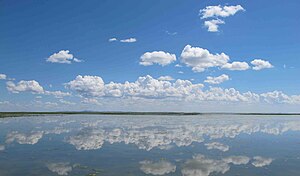Hulun lake
|
Hulun Lake Hulun Nur |
||
|---|---|---|

|
||
| Geographical location | Inner Mongolia , People's Republic of China | |
| Tributaries | Cherlen , Orxon | |
| Drain | Argun (temporarily) | |
| Data | ||
| Coordinates | 48 ° 58 ' N , 117 ° 26' E | |
|
|
||
| Altitude above sea level | 539 m | |
| surface | 2 315 km² | |
| length | 93 km | |
| width | 32 km | |
| Middle deep | 6-9 m | |

|
||
| Course of the Cherlen / Kerulen and the Hulun Nur | ||
Lake Hulun ( Mongolian : Hulun Nur or Dalai nuur ( Далай нуур ), Chinese 呼倫湖 , Pinyin Hūlún Hú ) is a large freshwater inland lake in northeast China , in the extreme northeast of the Inner Mongolia Autonomous Region , in the Hulun Buir - Grasslands, on the Barga plateau . The lake is usually without a drain. When the water level in the lake is high, it flows into the Argun River .
With 2315 km² (according to other data 1100 km²) the Hulun Nur is the largest lake in Inner Mongolia and the fifth largest in China. The lake is only six to nine meters deep, depending on the amount of precipitation, and is at an altitude of 539 m . The banks are relatively flat and consist of both stony and sandy sections.
Depending on its inflow, it is up to 93 km long and 32 km wide. On its south-west bank it is fed by the Cherlen and on its east bank by the Orxon .
At least 30 species of fish have settled in the lake, over 200 species of birds not only populate its banks; this includes cranes such as the extremely rare red-crowned crane , swans, wild geese, wild ducks and migratory birds, which visit the lake and its banks as resting and breeding places and foraging. As an astonishingly clean lake in China, the lake is increasingly becoming a popular travel destination with holiday and health resorts. The lake is often frozen over in winter.
The lake is located 150 km east of the Hailar district in the administrative area of the district-free city of Hulun Buir .
Outflow: Kerulen-Argun-Amur
In years with particularly high levels of rainfall, the normally outflow-free lake overflows on its north bank, so that the Kerulen that feeds it gets a connection to the Argun, which flows a little further east, and to the Amur that flows into it. This creates the Kerulen-Argun-Amur River , which is then the seventh longest river in the world.
